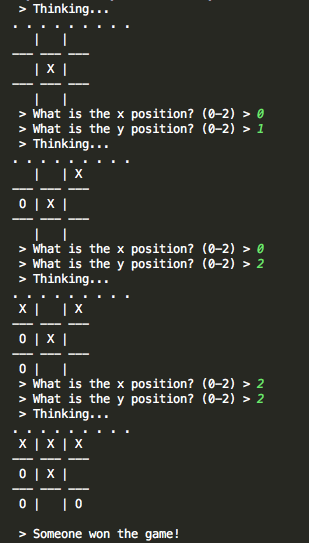As my senior year of high school began to slow down and the college hype began to increase, I looked for simple projects to work on while in the midst of the craziness. Looking at the history of Artificial Intelligence, I began to read up on the different methods AI developers used before modern AI existed (Neural Networks would be an example of a modern day technique). I also decided to code this project in Python in order to broaden my skills with other languages (and because Python is pretty fun to use).
Artificial Intelligence for games like TicTacToe and Minimax are prime examples of early stage AI – programs that brute search their way through an entire list of possible situations in order to find the best action to take. However, brute searching only works on games with a small amount of game boards. For instance, Minimax is a really simple game because the amount of choices and paths players can take is very limited. TicTacToe ramps it up a little (about 9! or 362,880 different ways to play the game), but is still feasible with a little bit of load time. Games like chess, however, are almost impossible to brute search just from the sheer amount of games possible (about 10^10^50 games, in fact, there are more games of chess than grains of sand on the Earth). This means that although brute searching is an alright method to use when creating game AI, it isn’t always the most efficient, and other options should be considered the more complex the game is.
One of the main roadblocks I hit along the way on this project was dealing with recursion. I am familiar with recursion and its usefulness, but for more complicated tasks like this, it can become confusing at times (especially writing in an unfamiliar language, might I add). For those who don’t know much about recursion, it’s essentially a function that calls itself in order to simplify a problem. It’s complicated in that its formation is very abstract and you have to keep some key issues in mind while creating recursive functions (i.e., making sure you don’t accidentally create a function that loops indefinitely). After some frustration / hair pulling out, I was able to overcome the challenge and write a program that performs pretty well. Basically, the AI looks at each possible choice it has and finds the probability it will win if it chooses that path taking into consideration all possible game boards extending from that board. After probabilities for each possible spot to play are calculated, the AI chooses the option with the highest probability of success.

Here the AI is controlling Xs and I am controlling Os. You can see the AI was successfully able to perform a double attack, forcing a win for Xs.
This project was fun to make. Comparing it with the Neural Networks I’ve made this year, It’s amazing to see how far Computer Scientists have come in terms of Artificial Intelligence and the ability for computers to recognize patterns and solve problems. If you want to see the code for this project, you can get it here: https://github.com/mccloskeybr/tictactoe
Recent Comments